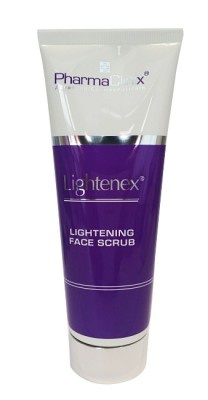
Lightenex® Face Scrub & Wash
Highlights
Key Ingredients
Other Ingredients
Skim through
| Ingredient name | what-it-does | irr., com. | ID-Rating |
|---|---|---|---|
| Niacinamide | cell-communicating ingredient, skin brightening, anti-acne, moisturizer/humectant | superstar | |
| Papain | 0, 0 | ||
| Bromelain | |||
| Mannitol | moisturizer/humectant | goodie | |
| Solanum Lycopersicum Extract | antioxidant | ||
| Citrus Unshiu Peel Extract | skin brightening, antioxidant | ||
| Glycyrrhiza Glabra Extract | soothing, skin brightening | superstar | |
| Sodium Lauroyl Lactylate | emulsifying |
Pharmaclinix Lightenex® Face Scrub & WashIngredients explained
- A multi-functional skincare superstar with several proven benefits for the skin
- Great anti-aging, wrinkle smoothing ingredient used at 4-5% concentration
- Fades brown spots alone or in combination with amino sugar, acetyl glucosamine
- Increases ceramide synthesis that results in a stronger, healthier skin barrier and better skin hydration
- Can help to improve several skin conditions including acne, rosacea, and atopic dermatitis

A type of sugar molecule, that has water-binding properties and helps to keep your skin hydrated.

Out of the more than 900 Citrus species known today, Citrus Unshiu is a seedless, easy to peel tangerine coming from the Japanese town Satsuma. The peel extract used in cosmetics is mainly created from the "press-cake", the by-product of the juice industry and as it turns out, what's waste to one industry is a useful ingredient to another.
In cosmetics, the main thing of the Citrus Unshiu Peel Extract is being a skin-brightening or whitening agent. In-vitro (made in test tubes) and animal studies both show promising results for inhibiting tyrosinase, the famous enzyme regulating melanin production. It also contains antioxidant components such as carotenoids, coumarins, limonoids, and flavonoids that might be useful for the skin to protect itself from UV caused damages.
The downside of citrus peel extracts (that prevents our goodie rating) is that they usually contain some amount of essential oil components, though the amount is probably way too low to worry about unless you're super-duper sensitive.
You might know licorice as a sweet treat from your childhood, but it's actually a legume that grows around the Mediterranean Sea, the Middle East, central and southern Russia. It's sweet and yellow and not only used for licorice all sorts but it's also a skincare superstar thanks to two magic properties:
Nr. 1 magic property is that it has skin-lightening or to say it another way depigmenting properties. The most active part is called glabridin. The topical application (meaning when you put it on your face) of 0.5% glabridin was shown to inhibit UVB caused pigmentation of guinea pigs. Another study even suggested that licorice is more effective than the gold standard skin-lightening agent hydroquinone. All in all, licorice is considered to be one of the safest skin lightening agents with the fewest side effects.
There is just one catch regarding glabridin and licorice: the amount of glabridin in commercial licorice extracts can vary a lot. We have seen extracts with only 4% glabridin as well as 40% glabridin. The latter one is a very-very expensive ingredient, so if you are after the depigmenting properties try to choose a product that boasts its high-quality licorice extract.
Nr. 2 magic property is that licorice is a potent anti-inflammatory. Glabridin has also some soothing properties but the main active anti-inflammatory component is glycyrrhizin. It’s used to treat several skin diseases that are connected to inflammation including atopic dermatitis, rosacea or eczema.
Oh, and one more thing: glabridin seems to be also an antioxidant, which is just one more reason to be happy about licorice root extract on an ingredient list.
Bottom line: Licorice is a great skincare ingredient with significant depigmenting, anti-inflammatory and even some antioxidant properties. Be happy if it's on the ingredient list. :)
A helper ingredient that's used as a co-emulsifier (meaning next to other emulsifiers in the formula it helps water and oil to mix) and as a stabilization agent for foams. Also, has some antimicrobial activity so it can help to boost the effectiveness of the preservative system.
You may also want to take a look at...
| what‑it‑does | cell-communicating ingredient | skin brightening | anti-acne | moisturizer/humectant |
| irritancy, com. | 0, 0 |
| what‑it‑does | moisturizer/humectant |
| what‑it‑does | antioxidant |
| what‑it‑does | skin brightening | antioxidant |
| what‑it‑does | soothing | skin brightening |
| what‑it‑does | emulsifying |





